Parts of the body guessing
Download as pptx, pdf0 likes723 views
This document lists different parts of the human body starting with the head including hair, eyes, ears, nose, and mouth. It then mentions the tummy, shoulders, arms, hands, fingers, legs, knees, feet, and toes.
1 of 31
Download to read offline
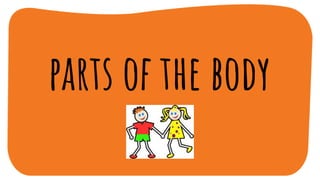
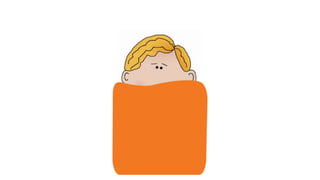
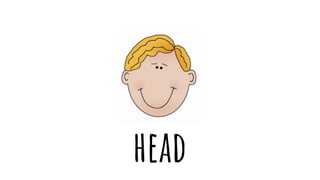
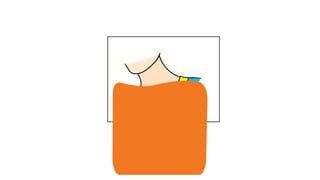








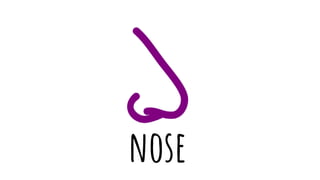

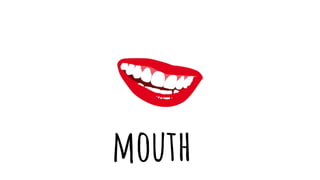
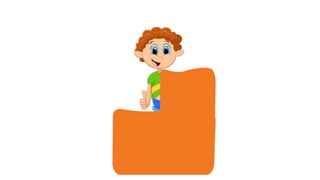
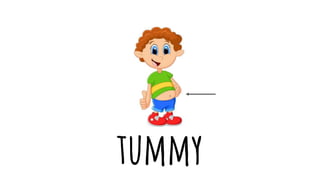
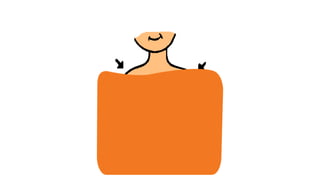
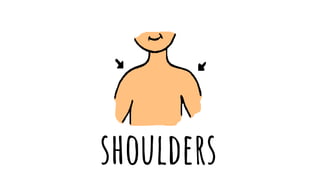
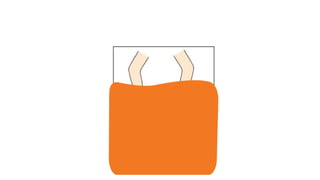
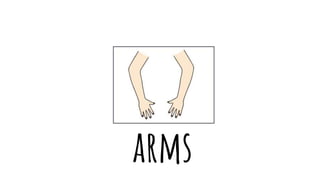
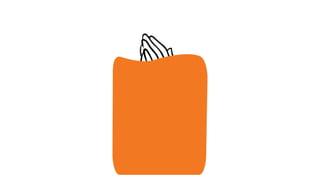
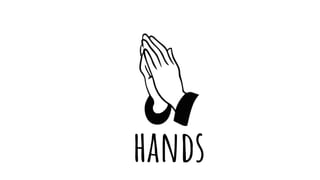
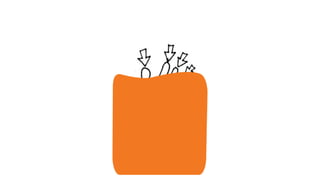
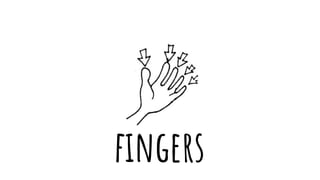

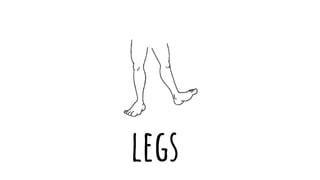
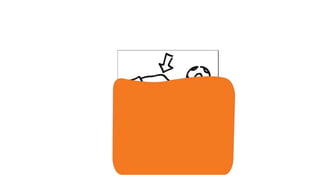
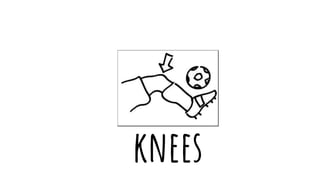
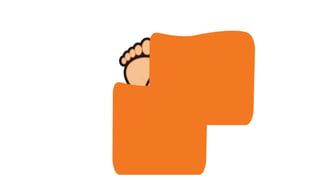
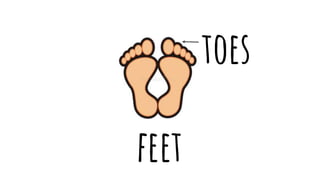
Ad
Recommended
Body parts and face
Body parts and facejoangoes
╠²
The document describes the three main parts of the human body: the head, torso, and limbs. The head contains the face which has features like eyes, nose, mouth, ears, hair, eyebrows, eyelashes, cheeks and chin. The torso section houses the chest, stomach, and back. The limbs are described as the arms and legs.Vocabulary Body
Vocabulary Bodykikuya
╠²
This document lists the main parts of the human body including the head, eyes, nose, ears, mouth, neck, shoulders, arms, knees, legs, feet, and hands.My body
My bodyCRISTINA ÁLVAREZ
╠²
This document describes the main parts of the human body including the head, eyes, nose, hair, teeth, ears, arms, hands, legs, and feet. It lists these body parts in sentences and then provides a concluding list of the head, arms, hands, legs, and feet to summarize the key parts of the human body discussed.Parts of Body
Parts of BodyMurat Akt├╝rk
╠²
This document lists parts of the body including eyes, ears, nose, mouth, hair, hands, fingers, legs, knees, arms, head, and belly. It then describes a dream of a monster with three large eyes, long hair, a small nose, and six small ears, along with four hands and twenty fingers.Parts of the Body
Parts of the BodyMAILYNVIODOR1
╠²
This document lists and describes various parts of the human body and their functions. It outlines that the eyes are used for seeing, the nose for smelling, the ears for listening, the hands for touching and holding things, the feet and legs for walking, running, and climbing, and the tongue for tasting.Recordando: Parts of the Body
Recordando: Parts of the BodyCarolina Paz Cornejo Melendez
╠²
The document discusses different parts of the human body. It defines the arm as the part of the upper limb between the shoulder and elbow joints. It also defines the leg as the anatomical structure used for locomotion. It states that the head usually comprises structures like the brain, eyes, ears, nose and mouth, which aid in sensory functions like sight, hearing, smell and taste.Body Parts - Primary 3
Body Parts - Primary 3udalaitz
╠²
This document discusses different parts of the human body including the head, hair, eyes, nose, mouth, ears, shoulders, arms, hands, fingers, torso, legs, knees, ankles, and feet. It also mentions clicking on links and contains menus for the body and the main sections.My body and head
My body and headCarlos Mercader Conesa
╠²
This document describes the basic parts of the human body including the head, arm, trunk, and leg as main body parts as well as shoulders, elbows, tummy, and knees as subparts. It then focuses more on the head, listing hair, ears, eyes, nose, and mouth as features of the head.Human Body
Human BodyClare Cato
╠²
The document lists and defines the main parts of the human body including the head, eyes, nose, mouth, arms, hands, belly, chest, neck, legs, feet and knees. It breaks the body down into sections including the head, arms, belly and legs while naming specific parts within each section like eyes and nose within the head or hands within the arms.Body parts game for 2nd Graders. A1 k─░DS
Body parts game for 2nd Graders. A1 k─░DSAy┼¤e Turan
╠²
This document lists various body parts including hands, head, knee, ears, eyes, mouth, nose, neck, ear, legs, arm, foot, shoulders, fingers, toes, and finger. It repeats several body parts such as eyes, ears, feet, and hands.Bee slide
Bee slideWendy French
╠²
This document discusses different types of bees and their behaviors, asking which bee is different, what bees are doing, and which flower colors bees like. It also lists the main body parts of bees, such as their abdomen, legs, thorax, wings, head, and antennae. Finally, it asks if you can drink like a bee.Joints
JointsTeacherLuis0311
╠²
This document lists and describes various parts of the human body including arms, legs, fingers, toes, eyes, ears, nose, mouth, eyebrows, eyelashes, chin, cheeks and joints. It specifies that joints like the shoulder, elbow, wrist, hip, knee and ankle help the body move and are located in the arms, legs, neck and jaw.Joints
JointsTeacherLuis0311
╠²
This document lists and groups different body parts such as the arm, tummy, bottom, foot, fingers, and hand. It also identifies joints in the body like the hip, knee, ankle, shoulder, elbow, and wrist that help the body move. These joints are located in the legs and arms and allow movement at the ankle, knee, hip, shoulder, wrist, elbow, and neck.Parts of my body
Parts of my bodygerardlopezperez
╠²
This document lists various parts of the human body including the eyebrow, eye, mouth, cheek, chin, chest, arm, leg, foot, head, forehead, nose, ear, neck, lips, shoulder, hip, forearm, elbow, calf, hand, thigh, ankle, shin, toe, palm, wrist, thumb, finger and hand.Unit 1 'All about me'
Unit 1 'All about me'TeacherConchi
╠²
This document lists and describes the main parts of the human body including the head, eyes, nose, ears, mouth, hands, fingers, legs, feet, and joints. It explains that the body has three main parts - the head, torso, and limbs. The five senses of sight, smell, hearing, touch, and taste are also mentioned.Body (nx power lite)
Body (nx power lite)Vanda Mata
╠²
This document lists various body parts in an unconventional order, including shoulder, arm, leg, finger, knee, head, nose, hand, foot and ankle.Parts of the body
Parts of the bodyalejandro torc
╠²
This document lists and defines common parts of the human body in Spanish. It includes head-related parts like hair, eyebrows, forehead, eyes, nose, mouth, teeth, lips, throat, and face. It also lists arms and hands with fingers specified. Other body parts mentioned are shoulders, chest, abdomen, legs, knees, feet and toes.My body 2
My body 2sciencesantaana
╠²
The document discusses the main parts and organs of the human body. It is divided into sections on parts of the body, bones, joints, organs, and breathing. The three main parts of the body are the head, trunk, and limbs. The skeleton is made up of many bones, including the skull, ribs, and spine. Joints connect all of the bones. Important organs are the brain, lungs, and heart. The process of breathing involves air entering through the nose, traveling through the trachea, and entering the lungs.Head, trunk and limbs
Head, trunk and limbsCarlos Mercader Conesa
╠²
This document describes the three main parts of the human body - the head, trunk, and limbs. It then lists some actions that can be performed using the limbs, including running with legs, throwing a ball with arms, kicking a ball with legs, and catching a ball with arms. The document concludes by asking the reader to match each limb with its corresponding action.Parts of the body
Parts of the bodyjoseklo
╠²
This document lists and defines various parts of the human body, grouping them into sections on the face, head, eye, mouth, hand, arm, leg, and torso. It provides the names of over 30 different body parts, describing areas like the hair, ears, eyes, nose, mouth, fingers, shoulders, knees, chest, hips and more.Get ready
Get readyjp098
╠²
This document provides instructions for getting ready for the day in a brain-smart way. It suggests engaging in physical activities like shaking, stretching, crossing arms, and breathing to get the body and brain ready. It also recommends connecting with a friend through actions like shaking hands, clapping, and hugging to engage socially before starting the day.Natural Science - Unit 1 - My Body
Natural Science - Unit 1 - My BodyDavid Santos
╠²
The document discusses the basic parts and functions of the human body. It notes that the body has three main parts - the head, torso, and limbs. It states that the arms and legs are limbs and that joints like the wrist and elbow allow movement. The skeleton supports and protects the body, while muscles help power movement, and humans grow and experience different emotions.OUR FIVE SENSES- SESSION 1 YEAR 2
OUR FIVE SENSES- SESSION 1 YEAR 2Mar├Ła Gonz├Īlez Bueno
╠²
Our five senses of sight, hearing, smell, taste and touch collect information through our eyes, ears, nose, tongue and skin and send it to our brain to help us understand the world around us; we can see with our eyes, hear with our ears, smell with our nose, taste with our tongue, and touch with our hands.Parts of the body, TERE AMAYA TORRES
Parts of the body, TERE AMAYA TORRESUNIVERSIDAD SANTANDER
╠²
This document lists and defines the main parts of the human body including the head, hair, nose, ears, eyes, mouth, hands, fingers, arms, knees, shoulders, feet, toes, and legs. It instructs students to look at the parts, repeat them, and then practice identifying them with a classmate.External features of the animals
External features of the animalsvibila
╠²
The document discusses how animals can be identified and grouped based on their external features. It provides examples of different animal external features such as wings, beaks, feathers, claws, tails, trunks, tusks, fins, shells, scales, horns, and hair. Animals that share similar external features can be grouped together, and larger groups can then be further divided into smaller subgroups based on additional distinguishing characteristics.BODY SYSTEMS AND 5 SENSES
BODY SYSTEMS AND 5 SENSESTeacherConchi
╠²
The document provides an overview of the human body systems including the brain, senses, circulatory system, respiratory system, and digestive system. It discusses the main external and internal parts of the eye, ear, nose, tongue, skin, lungs, heart, blood vessels, stomach, and intestines. The three body systems studied are the brain and senses, circulatory system, and respiratory system. The document aims to teach students about the basic structures and functions of the key organs that work together in the human body.Presentation of the senses for Primary Students. Natural Science.
Presentation of the senses for Primary Students. Natural Science.ACr Apellidos
╠²
The document discusses the 5 human senses - sight, smell, hearing, taste, and touch. It describes each sense and the body part used, such as eyes for sight and nose for smell. It emphasizes taking care of the senses for good health.Parts of the body bits
Parts of the body bitsCatalina Perkins
╠²
This document lists and describes various parts of the human body including the head, neck, hair, eyes, ears, nose, mouth, tummy, shoulders, arms, hands, fingers, legs, knees, feet and toes.More Related Content
What's hot (19)
Human Body
Human BodyClare Cato
╠²
The document lists and defines the main parts of the human body including the head, eyes, nose, mouth, arms, hands, belly, chest, neck, legs, feet and knees. It breaks the body down into sections including the head, arms, belly and legs while naming specific parts within each section like eyes and nose within the head or hands within the arms.Body parts game for 2nd Graders. A1 k─░DS
Body parts game for 2nd Graders. A1 k─░DSAy┼¤e Turan
╠²
This document lists various body parts including hands, head, knee, ears, eyes, mouth, nose, neck, ear, legs, arm, foot, shoulders, fingers, toes, and finger. It repeats several body parts such as eyes, ears, feet, and hands.Bee slide
Bee slideWendy French
╠²
This document discusses different types of bees and their behaviors, asking which bee is different, what bees are doing, and which flower colors bees like. It also lists the main body parts of bees, such as their abdomen, legs, thorax, wings, head, and antennae. Finally, it asks if you can drink like a bee.Joints
JointsTeacherLuis0311
╠²
This document lists and describes various parts of the human body including arms, legs, fingers, toes, eyes, ears, nose, mouth, eyebrows, eyelashes, chin, cheeks and joints. It specifies that joints like the shoulder, elbow, wrist, hip, knee and ankle help the body move and are located in the arms, legs, neck and jaw.Joints
JointsTeacherLuis0311
╠²
This document lists and groups different body parts such as the arm, tummy, bottom, foot, fingers, and hand. It also identifies joints in the body like the hip, knee, ankle, shoulder, elbow, and wrist that help the body move. These joints are located in the legs and arms and allow movement at the ankle, knee, hip, shoulder, wrist, elbow, and neck.Parts of my body
Parts of my bodygerardlopezperez
╠²
This document lists various parts of the human body including the eyebrow, eye, mouth, cheek, chin, chest, arm, leg, foot, head, forehead, nose, ear, neck, lips, shoulder, hip, forearm, elbow, calf, hand, thigh, ankle, shin, toe, palm, wrist, thumb, finger and hand.Unit 1 'All about me'
Unit 1 'All about me'TeacherConchi
╠²
This document lists and describes the main parts of the human body including the head, eyes, nose, ears, mouth, hands, fingers, legs, feet, and joints. It explains that the body has three main parts - the head, torso, and limbs. The five senses of sight, smell, hearing, touch, and taste are also mentioned.Body (nx power lite)
Body (nx power lite)Vanda Mata
╠²
This document lists various body parts in an unconventional order, including shoulder, arm, leg, finger, knee, head, nose, hand, foot and ankle.Parts of the body
Parts of the bodyalejandro torc
╠²
This document lists and defines common parts of the human body in Spanish. It includes head-related parts like hair, eyebrows, forehead, eyes, nose, mouth, teeth, lips, throat, and face. It also lists arms and hands with fingers specified. Other body parts mentioned are shoulders, chest, abdomen, legs, knees, feet and toes.My body 2
My body 2sciencesantaana
╠²
The document discusses the main parts and organs of the human body. It is divided into sections on parts of the body, bones, joints, organs, and breathing. The three main parts of the body are the head, trunk, and limbs. The skeleton is made up of many bones, including the skull, ribs, and spine. Joints connect all of the bones. Important organs are the brain, lungs, and heart. The process of breathing involves air entering through the nose, traveling through the trachea, and entering the lungs.Head, trunk and limbs
Head, trunk and limbsCarlos Mercader Conesa
╠²
This document describes the three main parts of the human body - the head, trunk, and limbs. It then lists some actions that can be performed using the limbs, including running with legs, throwing a ball with arms, kicking a ball with legs, and catching a ball with arms. The document concludes by asking the reader to match each limb with its corresponding action.Parts of the body
Parts of the bodyjoseklo
╠²
This document lists and defines various parts of the human body, grouping them into sections on the face, head, eye, mouth, hand, arm, leg, and torso. It provides the names of over 30 different body parts, describing areas like the hair, ears, eyes, nose, mouth, fingers, shoulders, knees, chest, hips and more.Get ready
Get readyjp098
╠²
This document provides instructions for getting ready for the day in a brain-smart way. It suggests engaging in physical activities like shaking, stretching, crossing arms, and breathing to get the body and brain ready. It also recommends connecting with a friend through actions like shaking hands, clapping, and hugging to engage socially before starting the day.Natural Science - Unit 1 - My Body
Natural Science - Unit 1 - My BodyDavid Santos
╠²
The document discusses the basic parts and functions of the human body. It notes that the body has three main parts - the head, torso, and limbs. It states that the arms and legs are limbs and that joints like the wrist and elbow allow movement. The skeleton supports and protects the body, while muscles help power movement, and humans grow and experience different emotions.OUR FIVE SENSES- SESSION 1 YEAR 2
OUR FIVE SENSES- SESSION 1 YEAR 2Mar├Ła Gonz├Īlez Bueno
╠²
Our five senses of sight, hearing, smell, taste and touch collect information through our eyes, ears, nose, tongue and skin and send it to our brain to help us understand the world around us; we can see with our eyes, hear with our ears, smell with our nose, taste with our tongue, and touch with our hands.Parts of the body, TERE AMAYA TORRES
Parts of the body, TERE AMAYA TORRESUNIVERSIDAD SANTANDER
╠²
This document lists and defines the main parts of the human body including the head, hair, nose, ears, eyes, mouth, hands, fingers, arms, knees, shoulders, feet, toes, and legs. It instructs students to look at the parts, repeat them, and then practice identifying them with a classmate.External features of the animals
External features of the animalsvibila
╠²
The document discusses how animals can be identified and grouped based on their external features. It provides examples of different animal external features such as wings, beaks, feathers, claws, tails, trunks, tusks, fins, shells, scales, horns, and hair. Animals that share similar external features can be grouped together, and larger groups can then be further divided into smaller subgroups based on additional distinguishing characteristics.BODY SYSTEMS AND 5 SENSES
BODY SYSTEMS AND 5 SENSESTeacherConchi
╠²
The document provides an overview of the human body systems including the brain, senses, circulatory system, respiratory system, and digestive system. It discusses the main external and internal parts of the eye, ear, nose, tongue, skin, lungs, heart, blood vessels, stomach, and intestines. The three body systems studied are the brain and senses, circulatory system, and respiratory system. The document aims to teach students about the basic structures and functions of the key organs that work together in the human body.Presentation of the senses for Primary Students. Natural Science.
Presentation of the senses for Primary Students. Natural Science.ACr Apellidos
╠²
The document discusses the 5 human senses - sight, smell, hearing, taste, and touch. It describes each sense and the body part used, such as eyes for sight and nose for smell. It emphasizes taking care of the senses for good health.More from Catalina Perkins (20)
Parts of the body bits
Parts of the body bitsCatalina Perkins
╠²
This document lists and describes various parts of the human body including the head, neck, hair, eyes, ears, nose, mouth, tummy, shoulders, arms, hands, fingers, legs, knees, feet and toes. Places in the city game
Places in the city gameCatalina Perkins
╠²
This document lists various locations in a city including a bank, two restaurants, two book stores, a library, a playground, and a movie theatre.Farm animals
Farm animalsCatalina Perkins
╠²
This document lists common farm animals and their young. It pairs each adult animal with its offspring, such as pig with piglet, cow with calf, cat with kitten, and so on, showing the names for babies of different farm animals.Miss cata says...
Miss cata says...Catalina Perkins
╠²
This short document repeats the phrase "Miss Cata says..." multiple times without providing any other context or information. It does not have enough content to create a meaningful 3 sentence summary.Spot goes to the farm
Spot goes to the farmCatalina Perkins
╠²
The boy Spot goes with his dad to look for baby animals on their farm, asking animals in the barn, bushes, and straw if they have seen any calves, lambs, chicks, ducklings, goslings, or piglets. All the animals respond negatively until Spot finds some kittens hiding in the bushes. At the end, Spot confirms for his dad that they saw piglets and he found some kittens.Sound ie
Sound ieCatalina Perkins
╠²
This document provides a phonics lesson, beginning with a list of sight words for students to practice reading. It then introduces the "ie" sound and gives an example sentence using that sound. The document concludes by asking students to think of words containing the "oa" sound and signals that more practice will follow.Sound oa
Sound oaCatalina Perkins
╠²
Phonics lesson focused on the /oa/ sound, with examples of words containing that sound like goat and boat. Students sang a song and did practice identifying more /oa/ words. The lesson text included a short story about an oak tree falling on a goat.Sound b
Sound bCatalina Perkins
╠²
This document provides a phonics lesson, beginning with practicing reading words with short vowel sounds like "if", "fat", and "fun". It then introduces the "/b/" sound and an example story with Bee, Inky and Snake playing with a ball and bat in the park. The lesson concludes with singing a song and thinking of more words that contain the "/b/" sound.Our world poem
Our world poemCatalina Perkins
╠²
This short poem describes the colors of various natural elements in our world such as the grass, sky, moon, clouds, sun, trees, leaves, sunset, and air, concluding that we live in a wonderful world.Phonics sound g
Phonics sound gCatalina Perkins
╠²
Groups 1 and 2 had phonics practice on Monday April 13th, where they practiced reading words with different sounds and sang a song. They also thought of words with the /g/ sound and did some additional practice identifying that sound, like the gurgling noise water makes when it runs down the sink.Ad
Recently uploaded (20)
How to use search fetch method in Odoo 18
How to use search fetch method in Odoo 18Celine George
╠²
The search_fetch is a powerful ORM method used in Odoo for some specific addons to combine the functionality of search and read for more efficient data fetching. It might be used to search for records and fetch specific fields in a single call. It stores the result in the cache memory.Vitamin and Nutritional Deficiencies.pptx
Vitamin and Nutritional Deficiencies.pptxVishal Chanalia
╠²
Vitamin and nutritional deficiency occurs when the body does not receive enough essential nutrients, such as vitamins and minerals, needed for proper functioning. This can lead to various health problems, including weakened immunity, stunted growth, fatigue, poor wound healing, cognitive issues, and increased susceptibility to infections and diseases. Long-term deficiencies can cause serious and sometimes irreversible health complications.How payment terms are configured in Odoo 18
How payment terms are configured in Odoo 18Celine George
╠²
Payment terms in Odoo 18 help define the conditions for when invoices are due. This feature can split payments into multiple parts and automate due dates based on specific rules.Code Profiling in Odoo 18 - Odoo 18 ║▌║▌▀Żs
Code Profiling in Odoo 18 - Odoo 18 ║▌║▌▀ŻsCeline George
╠²
Profiling in Odoo identifies slow code and resource-heavy processes, ensuring better system performance. Odoo code profiling detects bottlenecks in custom modules, making it easier to improve speed and scalability.Aprendendo Arquitetura Framework Salesforce - Dia 02
Aprendendo Arquitetura Framework Salesforce - Dia 02Mauricio Alexandre Silva
╠²
Aprendendo Arquitetura Framework Salesforce - Dia 02
SCHIZOPHRENIA OTHER PSYCHOTIC DISORDER LIKE Persistent delusion/Capgras syndr...
SCHIZOPHRENIA OTHER PSYCHOTIC DISORDER LIKE Persistent delusion/Capgras syndr...parmarjuli1412
╠²
SCHIZOPHRENIA INCLUDED TOPIC IS INTRODUCTION, DEFINITION OF GENERAL TERM IN PSYCHIATRIC, THEN DIFINITION OF SCHIZOPHRENIA, EPIDERMIOLOGY, ETIOLOGICAL FACTORS, CLINICAL FEATURE(SIGN AND SYMPTOMS OF SCHIZOPHRENIA), CLINICAL TYPES OF SCHIZOPHRENIA, DIAGNOSIS, INVESTIGATION, TREATMENT MODALITIES(PHARMACOLOGICAL MANAGEMENT, PSYCHOTHERAPY, ECT, PSYCHO-SOCIO-REHABILITATION), NURSING MANAGEMENT(ASSESSMENT,DIAGNOSIS,NURSING INTERVENTION,AND EVALUATION), OTHER PSYCHOTIC DISORDER LIKE Persistent delusion/Capgras syndrome(The Delusion of Doubles)/Acute and Transient Psychotic Disorders/Induced Delusional Disorders/Schizoaffective Disorder /CAPGRAS SYNDROME(DELUSION OF DOUBLE), GERIATRIC CONSIDERATION, FOLLOW UP, HOMECARE AND REHABILITATION OF THE PATIENT, Birnagar High School Platinum Jubilee Quiz.pptx
Birnagar High School Platinum Jubilee Quiz.pptxSourav Kr Podder
╠²
Birnagar High School Platinum Jubilee Celebration QuizF-BLOCK ELEMENTS POWER POINT PRESENTATIONS
F-BLOCK ELEMENTS POWER POINT PRESENTATIONSmprpgcwa2024
╠²
F-block elements are a group of elements in the periodic table that have partially filled f-orbitals. They are also known as inner transition elements. F-block elements are divided into two series:
1.Lanthanides (La- Lu) These elements are also known as rare earth elements.
2.Actinides (Ac- Lr): These elements are radioactive and have complex electronic configurations.
F-block elements exhibit multiple oxidation states due to the availability of f-orbitals.
2. Many f-block compounds are colored due to f-f transitions.
3. F-block elements often exhibit paramagnetic or ferromagnetic behavior.4. Actinides are radioactive.
F-block elements are used as catalysts in various industrial processes.
Actinides are used in nuclear reactors and nuclear medicine.
F-block elements are used in lasers and phosphors due to their luminescent properties.
F-block elements have unique electronic and magnetic properties.Photo chemistry Power Point Presentation
Photo chemistry Power Point Presentationmprpgcwa2024
╠²
Photochemistry is the branch of chemistry that deals with the study of chemical reactions and processes initiated by light.
Photochemistry involves the interaction of light with molecules, leading to electronic excitation. Energy from light is transferred to molecules, initiating chemical reactions.
Photochemistry is used in solar cells to convert light into electrical energy.
It is used Light-driven chemical reactions for environmental remediation and synthesis. Photocatalysis helps in pollution abatement and environmental cleanup. Photodynamic therapy offers a targeted approach to treating diseases It is used in Light-activated treatment for cancer and other diseases.
Photochemistry is used to synthesize complex organic molecules.
Photochemistry contributes to the development of sustainable energy solutions.Romanticism in Love and Sacrifice An Analysis of Oscar WildeŌĆÖs The Nightingal...
Romanticism in Love and Sacrifice An Analysis of Oscar WildeŌĆÖs The Nightingal...KaryanaTantri21
╠²
The story revolves around a college student who despairs not having a red rose as a condition for dancing with the girl he loves. The nightingale hears his complaint and offers to create the red rose at the cost of his life. He sang a love song all night with his chest stuck to the thorns of the rose tree. Finally, the red rose grew, but his sacrifice was in vain. The girl rejected the flower because it didnŌĆÖt match her outfit and preferred a jewellery gift. The student threw the flower on the street and returned to studying philosophyList View Components in Odoo 18 - Odoo ║▌║▌▀Żs
List View Components in Odoo 18 - Odoo ║▌║▌▀ŻsCeline George
╠²
In Odoo, there are many types of views possible like List view, Kanban view, Calendar view, Pivot view, Search view, etc.
The major change that introduced in the Odoo 18 technical part in creating views is the tag <tree> got replaced with the <list> for creating list views. How to Manage Different Customer Addresses in Odoo 18 Accounting
How to Manage Different Customer Addresses in Odoo 18 AccountingCeline George
╠²
A business often have customers with multiple locations such as office, warehouse, home addresses and this feature allows us to associate with different addresses with each customer streamlining the process of creating sales order invoices and delivery orders.LDMMIA Shop & Student News Summer Solstice 25
LDMMIA Shop & Student News Summer Solstice 25LDM & Mia eStudios
╠²
6/18/25
Shop, Upcoming: Final Notes to Review as we Close Level One. Make sure to review the orientation and videos as well. ThereŌĆÖs more to come and material to cover in Levels 2-3. The content will be a combination of Reiki and Yoga. Also energy topics of our spiritual collective.
Thanks again all future Practitioner Level Students. Our Levels so far are: Guest, Grad, and Practitioner. We have had over 5k Spring Views.
https://ldm-mia.creator-spring.comFilipino 9 Maikling Kwento Ang Ama Panitikang Asiyano
Filipino 9 Maikling Kwento Ang Ama Panitikang Asiyanosumadsadjelly121997
╠²
Filipino 9 Maikling Kwento Ang Ama Panitikang AsiyanoHow to Customize Quotation Layouts in Odoo 18
How to Customize Quotation Layouts in Odoo 18Celine George
╠²
Customizing quotation layouts in Odoo 18 allows businesses to personalize their quotations to match branding or specific requirements. This can include adding logos, custom fields, or modifying headers and footers. Q1_ENGLISH_PPT_WEEK 1 power point grade 3 Quarter 1 week 1
Q1_ENGLISH_PPT_WEEK 1 power point grade 3 Quarter 1 week 1jutaydeonne
╠²
Grade 3 Quarter 1 Week 1 English part 2Great Governors' Send-Off Quiz 2025 Prelims IIT KGP
Great Governors' Send-Off Quiz 2025 Prelims IIT KGPIIT Kharagpur Quiz Club
╠²
Prelims of the Great Governors' Send-Off Quiz 2025 hosted by the outgoing governors.
QMs: Aarushi, Aatir, Aditya, ArnavChalukyas of Gujrat, Solanki Dynasty NEP.pptx
Chalukyas of Gujrat, Solanki Dynasty NEP.pptxDr. Ravi Shankar Arya Mahila P. G. College, Banaras Hindu University, Varanasi, India.
╠²
This presentation has been made keeping in mind the students of undergraduate and postgraduate level. In this slide try to present the brief history of Chaulukyas of Gujrat up to Kumarpala To keep the facts in a natural form and to display the material in more detail, the help of various books, websites and online medium has been taken. Whatever medium the material or facts have been taken from, an attempt has been made by the presenter to give their reference at the end.
Chaulukya or Solanki was one of the Rajputs born from Agnikul. In the Vadnagar inscription, the origin of this dynasty is told from Brahma's Chauluk or Kamandalu. They ruled in Gujarat from the latter half of the tenth century to the beginning of the thirteenth century. Their capital was in Anahilwad. It is not certain whether it had any relation with the Chalukya dynasty of the south or not. It is worth mentioning that the name of the dynasty of the south was 'Chaluky' while the dynasty of Gujarat has been called 'Chaulukya'. The rulers of this dynasty were the supporters and patrons of Jainism.ECONOMICS, DISASTER MANAGEMENT, ROAD SAFETY - STUDY MATERIAL [10TH]
ECONOMICS, DISASTER MANAGEMENT, ROAD SAFETY - STUDY MATERIAL [10TH]SHERAZ AHMAD LONE
╠²
This study material for Class 10th covers the core subjects of Economics, Disaster Management, and Road Safety Education, developed strictly in line with the JKBOSE textbook. It presents the content in a simplified, structured, and student-friendly format, ensuring clarity in concepts. The material includes reframed explanations, flowcharts, infographics, and key point summaries to support better understanding and retention. Designed for classroom teaching and exam preparation, it aims to enhance comprehension, critical thinking, and practical awareness among students.University of Ghana Cracks Down on Misconduct: Over 100 Students Sanctioned
University of Ghana Cracks Down on Misconduct: Over 100 Students SanctionedKweku Zurek
╠²
University of Ghana Cracks Down on Misconduct: Over 100 Students Sanctioned
Chalukyas of Gujrat, Solanki Dynasty NEP.pptx
Chalukyas of Gujrat, Solanki Dynasty NEP.pptxDr. Ravi Shankar Arya Mahila P. G. College, Banaras Hindu University, Varanasi, India.
╠²
Ad
Parts of the body guessing
- 1. parts of the body
- 2. head
- 3. head
- 4. neck
- 5. neck
- 6. hair
- 7. hair
- 8. eyes
- 9. eyes
- 10. ears
- 11. ears
- 12. nose
- 13. nose
- 14. mouth
- 15. mouth
- 16. tummy
- 17. tummy
- 18. shoulders
- 19. shoulders
- 20. arms
- 21. arms
- 22. hands
- 23. hands
- 24. fingers
- 25. fingers
- 26. legs
- 27. legs
- 28. knees
- 29. knees
- 30. feet toes
- 31. feet toes
